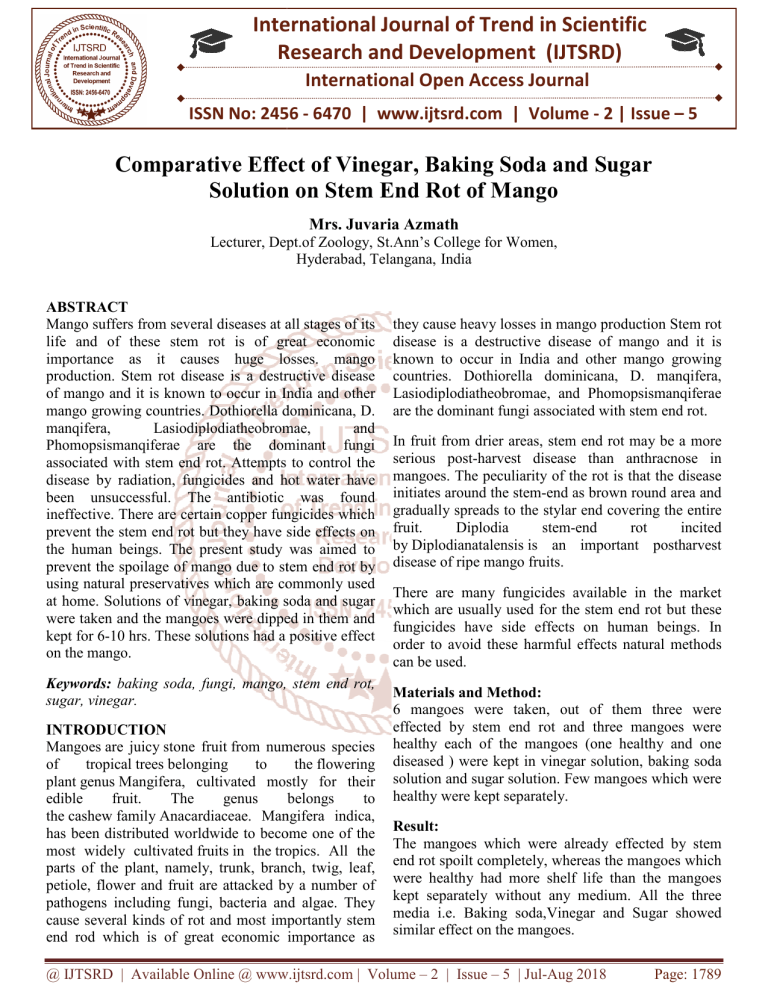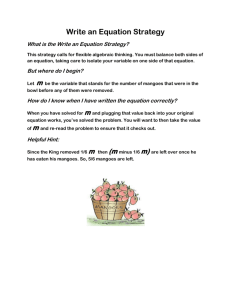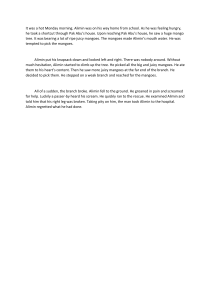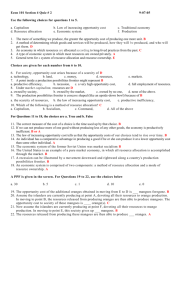
International Journal of Trend in Scientific
Research and Development (IJTSRD)
International Open Access Journal
ISSN No: 2456 - 6470 | www.ijtsrd.com | Volume - 2 | Issue – 5
Comparative Effect of Vinegar, Baking Soda and Sugar
Solution oon Stem End Rot of Mango
Mrs. Juvaria Azmath
Lecturer, Dept.of Zoology, St.Ann’s College for Women,
Hyderabad, Telangana, India
ABSTRACT
Mango suffers from several diseases at all stages of its
life and of these stem rot is of great economic
importance as it causes huge losses. mango
production. Stem rot disease is a destructive disease
of mango and it is known to occur in India and other
mango growing countries. Dothiorella dominicana, D.
manqifera,
Lasiodiplodiatheobromae,
theobromae,
and
Phomopsismanqiferae are the dominant fungi
associated with stem end rot. Attempts to control the
disease by radiation, fungicides and hot water have
been unsuccessful. The antibiotic was found
ineffective. There are certain copper fungicide
fungicides which
prevent the stem end rot but they have side effects on
the human beings. The present study was aimed to
prevent the spoilage of mango due to stem end rot by
using natural preservatives which are commonly used
at home. Solutions of vinegar, baking ssoda and sugar
were taken and the mangoes were dipped in them and
kept for 6-10
10 hrs. These solutions had a positive effect
on the mango.
Keywords: baking soda, fungi, mango, stem end rot,
sugar, vinegar.
INTRODUCTION
Mangoes are juicy stone fruit from numerous species
of
tropical trees belonging
to
the flowering
plant genus Mangifera,, cultivated mostly for their
edible
fruit.
The
genus
belongs
to
the cashew family Anacardiaceae. Mangifera indica
indica,
has been distributed worldwide to become one of the
most widely cultivated fruits in the tropics
tropics. All the
parts of the plant, namely, trunk, branch, twig, leaf,
petiole, flower and fruit are attacked by a number of
pathogens including fungi, bacteria and algae. They
cause several kinds of rot and most importantly stem
end rod which is of great economic importance as
they cause heavy losses in mango production Stem rot
disease is a destructivee disease of mango and it is
known to occur in India and other mango growing
countries. Dothiorella dominicana, D. manqifera,
Lasiodiplodiatheobromae,
bromae, and Phomopsismanqiferae
are the dominant fungi associated with stem end rot.
In fruit from drier areas, stem end rot may be a more
serious post-harvest
harvest disease than anthracnose in
mangoes. The peculiarity of the rot is that the disease
initiates around the stem-end
end as brown round area and
gradually spreads to the stylar end covering the entire
fruit.
Diplodia
stem--end
rot
incited
by Diplodianatalensis is an important postharvest
disease of ripe mango fruits.
There are many fungicides available in the market
which are usually used for the stem end rot but these
fungicides have side effects on human beings. In
I
order to avoid these harmful effects natural methods
can be used.
Materials and Method:
6 mangoes were taken, out of them three were
effected by stem end rot and three mangoes were
healthy each of the mangoes (one healthy and one
diseased ) were kept in vinegar solution, baking soda
solution and sugar solution. Few mangoes which were
healthy were kept separately.
Result:
The mangoes which were already effected by stem
end rot spoilt completely, whereas the mangoes which
were healthy had more shelf life than the mangoes
kept separately without any medium. All the three
media i.e. Baking soda,Vinegar and Sugar showed
similar effect on the mangoes.
@ IJTSRD | Available Online @ www.ijtsrd.com | Volume – 2 | Issue – 5 | Jul-Aug 2018
Page: 1789
International Journal of Trend in Scientific Research and Development (IJTSRD) ISSN: 2456-6470
2456
Mangoes before treating with the solutions:
Mangoes treated with
Vinegar
Mangoes treated with
baking soda
Mangoes treated with
sugar solution
Mangoes kept as control
Discussion: Use of vinegar and sugar to prevent
microbial growth is an ancient technique that remains
important today for the preservation of foods. Baking
soda is also used i many parts of the country to
preserve foods. Vinegar is made from the
fermentation of sugar and water solutions and is an
effective natural preservative.. The acetic acid
in vinegar kills microbes and stalls food spoilage
Bacteria evolved in environments where the
concentration of sugars and salts is the same as or
lower
than
those
inside
the
cell
cell.
High sugar concentrations cause the bacterium to lose
water by osmosis and it doesn't have any cellular
machinery to pump it back in against the osmotic
gradient. This is also called as sugar curing. The
other antimicrobial mechanisms of sugar include
interference with a microbe's enzyme activity and
compounds from the growth of certain other
organisms.
weakening the molecular structure of its DNA. Sugar
may also provide an indirect form of preservation by
serving to accelerate accumulation of antimicrobial
5. https://www.livestrong.com/article/301425-whathttps://www.livestrong.com/article/301425
are-some-natural-preservatives/
preservatives/
Conclusion:
The preservation of mangoes using solutions of
Baking soda, Vinegar and Sugar was found to be
effective and can be used as a convenient and cheap
option for preservation of mangoes.
References:
1. Fruit and Vegetable diseases by K. G. Mukerji
2. Post Harvest diseases of fruits and vegetables-R.
vegetables
Barkai Golan
3. https://www.daf.qld.gov.au/businesshttps://www.daf.qld.gov.au/business
priorities/plants/fruit-and.../stem
and.../stem-end-rot
4. https://www.actahort.org/books/24/24_44.htm
@ IJTSRD | Available Online @ www.ijtsrd.com | Volume – 2 | Issue – 5 | Jul-Aug 2018
Page: 1790






